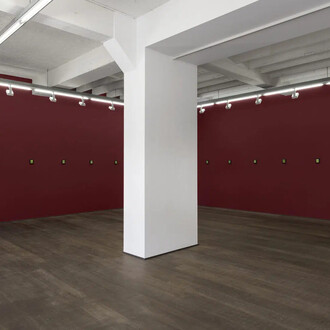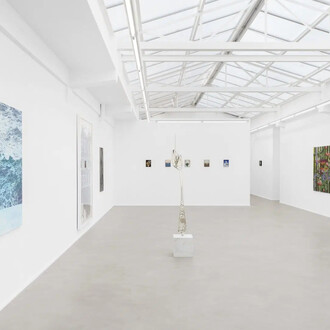Elie Borgrave. Balance of Opposites is the first retrospective devoted to this artist, whose painting is entirely dedicated to abstraction. Around forty paintings and drawings dating from the 1940s to the 1990s make it possible to discover a singular and an unknown work in the history of abstraction after 1945. Archived documents and old photographs show the man behind the artist. These unpublished documents also allow the visitor to enter the intimacy of the workshop. The exhibition follows the chronology of the painter's life led by Borgrave (1905-1992).
It all began in Brussels in 1946 when Borgrave exhibited his first paintings at the Galerie Louis Manteau. This gallery had served as a launching pad for young artists practicing abstraction, such as Mig Quinet. Although pictorially close to the Young Belgian Painters, he maintained a distance from his counterparts. In 1948, he left for the United States with the conviction that the future of modern art will take place on American soil.
Arriving in the United States in 1948, the artist participated in various collective events until January 1955 when he held his first solo exhibition at the Stable Gallery in New York. It was here that artists such as Rauschenberg, Pollock, Twombly and many others, exhibited their latest paintings. However, unlike the latter, Borgrave remained attached to a European tradition in his conception of abstract art. His sense of composition was rooted in Picasso's Cubism. His taste for color revealed an historic foundation in Fauvism. Like Kandinsky, Borgrave saw a poetic expansion of the world in painting.
Until then in my work, the search for perfection has often chosen either expression or emotion. In recent years, this has led to the discovery of cross-purposes in the work. The philosophical conclusions remain to be drawn.
In 1955, Borgrave returned to Europe. He lived in Italy, near Naples. The international aesthetic climate turned towards the celebration of pictorial matter. In the early 1960s, many painters were interested in the relationship between the form given by the artist and the raw material. For Belgian painters, the material remained pigmented. It is here that we must situate the contribution of Borgrave. As in the case of Serge Vandercam, Bram Bogart, Antoine Mortier, Mig Quinet and many others, Borgrave was viscerally attached to painting, whilst in France (Dubuffet), Italy (Burri) and Spain (Tapiès) the material was nourished by heterogeneous materials whose triviality traces the contours of a counterculture culminating in the events of May 1968. Borgrave did not follow this path that would lead outside of painting. His pictorial approach to materialism was based on mastery of the gesture and on the – european – principle of composition. Borgrave put in place a recurring pattern : producing a centrifugal movement by giving the viewer the impression that forms diverge from a central core to the boundaries of the painting.
The line is no longer, as in classical geometry, the appearance of a being contained in a vacuum. It is, as in moderate geometries, restriction, segregation and modulation of spatiality.
Borgrave settled near Paris from 1958 to 1962, then returned to Brussels before settling permanently in the Dutch village of Zuidzande, not far from Knokke-le-Zoute. The early 1960s was a transitional phase. On a personal level, the artist's life had a new beginning. His career restarted in 1963 when the Palais des Beaux-Arts in Brussels devoted a first exhibition to him. Several Belgian and Dutch galleries followed the movement. Pictorially, he abandoned the subject matter. What he was looking for from now on was the staging of a sign. The motif of the circle first interested Borgrave. In this series of paintings, each bore the imprint of the gesture deployed to trace the circle : its history is that of its manufacture. The question of duration is thus invoked in the conception of the painting. Significantly, the artist eradicated the effects of matter and, like Paul Klee, modified his format by favoring a horizontal support more adapted to the unfolding of time. This question of time then led Borgrave to produce kinetic effects by staging vertical bands, evoking the research conducted at the same time by Walter Leblanc. But where the latter explored new means of expression, Borgrave remained attached to painting. In the 1970s, the artist multiplied paintings composed of two geometric interlocking signs to give the viewer the impression of a visual balance based on the complementary nature of opposites. His interest in Oriental thought formed the basis of his paintings, evoking the fullness of Zen spirituality through pictorial means.
Order, balance, harmony : symbols of peace. This is what I wanted to express in a stripped-down visual language that may be related to some form of Buddhism.















